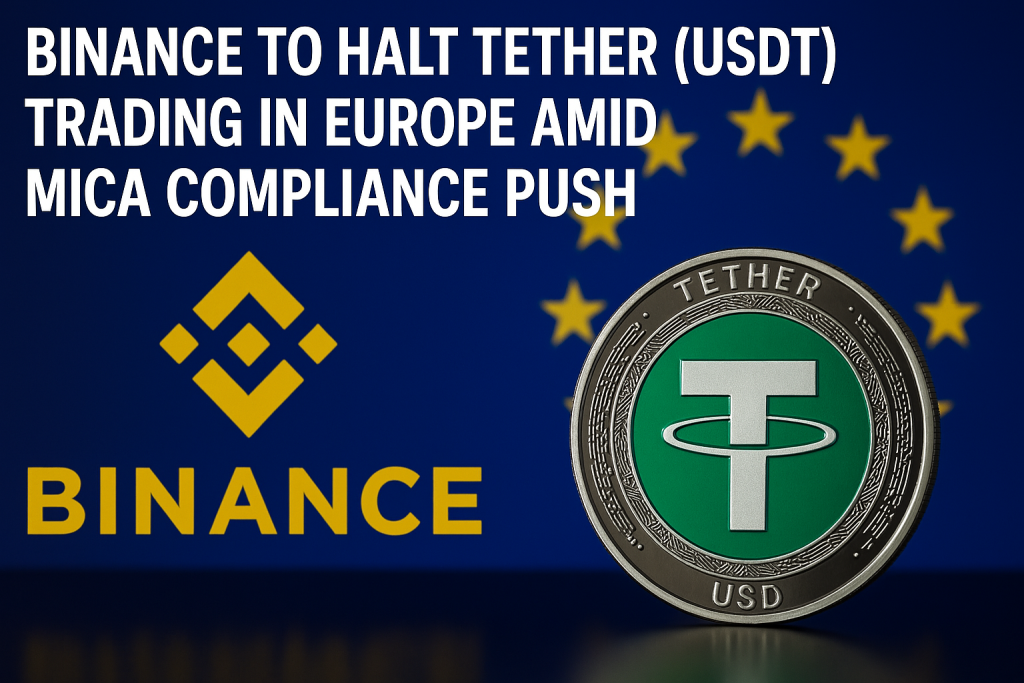⏲️ Estimated reading time: 3 min
Binance Ends Tether USDT Trading in Europe to Comply with MiCA Rules
Binance has announced it will stop Tether (USDT) trading in Europe, aligning with the EU’s upcoming MiCA regulations. This move marks a major shift in how stablecoins are regulated and used across European crypto markets.
Binance to Halt Tether (USDT) Trading in Europe Amid MiCA Compliance Push
In a major move driven by regulatory changes, Binance has confirmed that it will discontinue support for Tether’s USDT stablecoin trading in Europe. The decision is tied to the European Union’s upcoming Markets in Crypto-Assets (MiCA) regulation, set to come into full effect in late 2024. Binance, one of the world’s largest cryptocurrency exchanges, is adjusting its offerings to stay compliant ahead of time.

What Is MiCA and Why It Matters
The Markets in Crypto-Assets (MiCA) regulation is the EU’s first comprehensive crypto framework. Its main goal is to ensure stability, transparency, and consumer protection in the crypto sector. A significant part of MiCA focuses on stablecoins, requiring issuers to register and hold sufficient reserves. “This move marks a major shift in how regulators manage and users handle stablecoins across European crypto markets.”
Tether’s USDT, the most widely used stablecoin globally, is not issued or regulated under EU law. As a result, it falls into a grey area when it comes to MiCA compliance. Binance, seeking to avoid regulatory conflict, is now phasing out USDT trading pairs in Europe to align with the upcoming rules.
What This Means for European Crypto Traders
For crypto traders in the EU, this is a significant change. Tether (USDT) has long served as the go-to stablecoin for many trading pairs and DeFi protocols. With Binance removing USDT options, users will need to shift toward MiCA-compliant stablecoins, such as EURe (Euro-backed) or Circle’s USDC, which is preparing to meet MiCA requirements.
Binance has encouraged European users to begin converting their Tether holdings into compliant alternatives ahead of the cutoff. While the exact delisting date may vary by product. Users can expect spot and futures pairs involving USDT to be affected.
Impact on the Global Tether (USDT) Stablecoin Market
The decision sends a strong message to stablecoin issuers: compliance is no longer optional. The EU represents one of the world’s largest financial markets, and crypto companies that want access will need to meet regulatory standards.
Tether, which has previously faced scrutiny over its reserves and transparency, may now need to restructure its operations if it hopes to regain access to European platforms like Binance. In addition, the recent regulatory move could strengthen the position of regulator-approved stablecoins. As a result, these compliant alternatives may experience faster adoption within the EU crypto ecosystem. Moreover, the shift highlights the growing influence of MiCA regulations on shaping the future of digital assets in Europe.
Final Thoughts
Binance’s proactive approach to MiCA compliance is likely just the beginning. As more regions introduce crypto-specific legislation, exchanges will need to adapt quickly. For now, European users should prepare for a post-USDT environment and embrace the evolving, more regulated crypto landscape.
🏷️ Tags: Binance, Tether, USDT, MiCA, Europe Crypto, Stablecoins, Crypto Regulation, Binance Europe, Cryptocurrency News, MiCA Compliance
Only logged-in users can submit reports.
Discover more from HelpZone
Subscribe to get the latest posts sent to your email.

